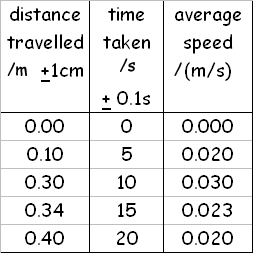
Experiments with 'speed'
- You have to chose a suitable instrument to measure distance and time. Those will vary with the task you are set.
- You have to have three columns in your results table - and they have to be correctly headed.
- The number of significant figures you put for the readings have to indicate how precisely you could measure. For example with a ruler you can measure to the nearest millimetre, but with a 2m tape measure to the nearest centimetre.
Table of results for an experiment using a stopwatch that measures to the nearest tenth of a second and a metre ruler with which you can measure to the nearest millimetre.

Table of results for an experiment using a stopwatch that measures to the nearest second and a two metre tape with which you can measure to the nearest centimetre.

The number of significant figures in the table you quote gives anyone looking at your results an idea of how sensitive the instrument that you used was. It is very important to do this correctly.
We use lots of special instruments to measure speed:
- the speedometer in a car gives an 'instantaneous' readout of your speed - click on the links to find out more!
- the air speed meter in a plane
- the mileometer calculates the distance travelled by a car
- a pedometer calculates the number of steps you take - program in your average length of stride and you get your distance travelled!


